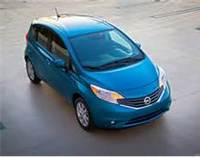Round view monitor and tire pressure monitoring among the features included in the 2014 Nissan Versa Note
 |
LAWRENCE, KS--Sept. 26, 2013: Ever since compact cars were first released, consumers have flocked to them for their superior fuel economies. In fact many consumers purchase the vehicles solely for the fuel economy. As efficiency is the focus, compacts don't come with hefty powertrain options, and their small size limits passenger and cargo volume. However, as the release of the 2014 Nissan Versa Note has shown, not all compacts fall into that stereotype. The manufacturer has given the Versa Note a best-in-class overall volume of 112.9 cubic feet.
The five-passenger Versa Note utilizes a hatchback body to maximize seating and storage capacities. When the seatback is upright, the Versa Note is rear seat is capable of fitting three full-sized adults with a best-in-class rear leg room of 38.3 inches. With the split fold-down rear seatback collapsed, the compact offers 38.3 cubic feet of storage. Storage options are further extended with a divide-n-hide adjustable floor which can keep items out of view when folded down, or add depth to the cargo area when folded up.
Consumers are also likely to appreciate the class-exclusive features that Nissan has equipped the Versa Note with. That includes an around view monitor which provides the driver with a 360 degree view around the hatchback. The system combines the feeds of four wide-angle cameras, and assists in all types of parking and blind sp pressure ot monitoring. Another class-exclusive feature that Nissan has added to the Versa Note is a tiremonitoring system. Tire pressure is crucial to achieving to most from the 40 MPG highway fuel economy, so the manufacturer has made it easy to keep pressure constant. The compact notifies the driver when tire pressure is low and needs to be adjusted. Once pressure is returned to the ideal level, the car's lights flash and the horn is sounded so that the driver knows when to stop filling the tires.


